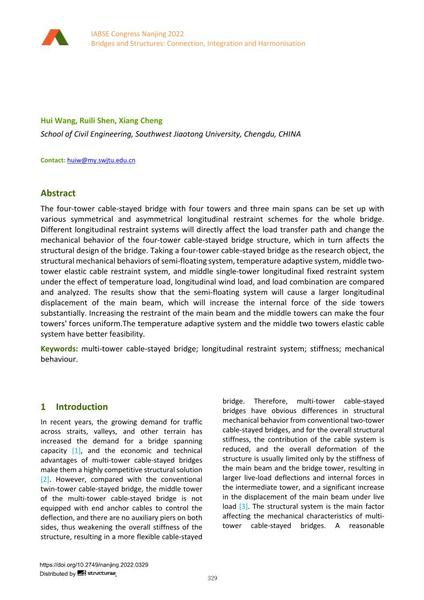Analysis of Reasonable Longitudinal Restraint System of Four-Tower Cable-Stayed Bridge

|
|
|||||||||||
Bibliografische Angaben
| Autor(en): |
Hui Wang
(School of Civil Engineering, Southwest Jiaotong University, Chengdu, China)
Ruili Shen (School of Civil Engineering, Southwest Jiaotong University, Chengdu, CHINA) Xiang Cheng (School of Civil Engineering, Southwest Jiaotong University, Chengdu, China) |
||||
|---|---|---|---|---|---|
| Medium: | Tagungsbeitrag | ||||
| Sprache(n): | Englisch | ||||
| Tagung: | IABSE Congress: Bridges and Structures: Connection, Integration and Harmonisation, Nanjing, People's Republic of China, 21-23 September 2022 | ||||
| Veröffentlicht in: | IABSE Congress Nanjing 2022 | ||||
|
|||||
| Seite(n): | 329-337 | ||||
| Anzahl der Seiten (im PDF): | 9 | ||||
| DOI: | 10.2749/nanjing.2022.0329 | ||||
| Abstrakt: |
The four-tower cable-stayed bridge with four towers and three main spans can be set up with various symmetrical and asymmetrical longitudinal restraint schemes for the whole bridge. Different longitudinal restraint systems will directly affect the load transfer path and change the mechanical behavior of the four-tower cable-stayed bridge structure, which in turn affects the structural design of the bridge. Taking a four-tower cable-stayed bridge as the research object, the structural mechanical behaviors of semi-floating system, temperature adaptive system, middle two- tower elastic cable restraint system, and middle single-tower longitudinal fixed restraint system under the effect of temperature load, longitudinal wind load, and load combination are compared and analyzed. The results show that the semi-floating system will cause a larger longitudinal displacement of the main beam, which will increase the internal force of the side towers substantially. Increasing the restraint of the main beam and the middle towers can make the four towers' forces uniform.The temperature adaptive system and the middle two towers elastic cable system have better feasibility. |
||||
| Stichwörter: |
Steifigkeit
|
||||
| Copyright: | © 2022 International Association for Bridge and Structural Engineering (IABSE) | ||||
| Lizenz: | Die Urheberrechte (Copyright) für dieses Werk sind rechtlich geschützt. Es darf nicht ohne die Zustimmung des Autors/der Autorin oder Rechteinhabers/-in weiter benutzt werden. |
||||

